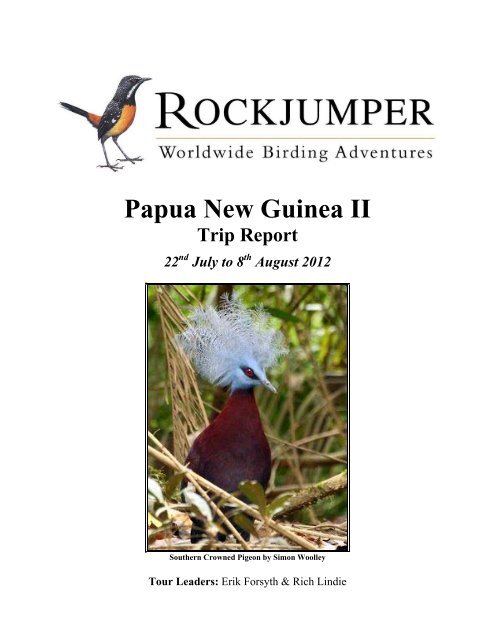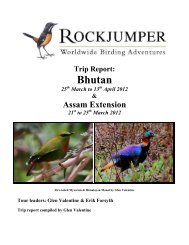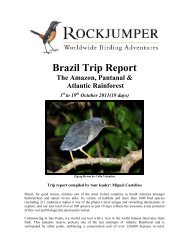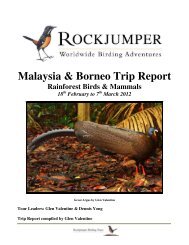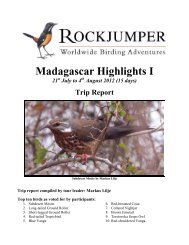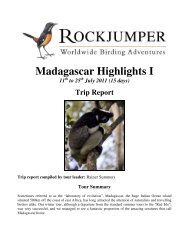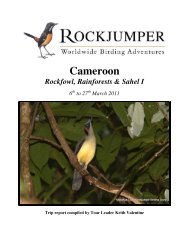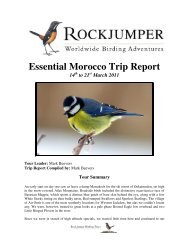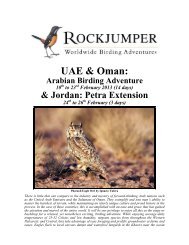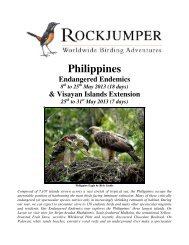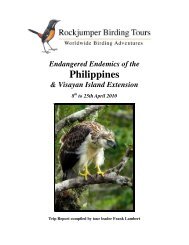Papua New Guinea II - Rockjumper Birding Tours
Papua New Guinea II - Rockjumper Birding Tours
Papua New Guinea II - Rockjumper Birding Tours
Create successful ePaper yourself
Turn your PDF publications into a flip-book with our unique Google optimized e-Paper software.
<strong>Papua</strong> <strong>New</strong> <strong>Guinea</strong> <strong>II</strong><br />
Trip Report<br />
22 nd July to 8 th August 2012<br />
Southern Crowned Pigeon by Simon Woolley<br />
Tour Leaders: Erik Forsyth & Rich Lindie
RBT Trip Report – <strong>Papua</strong> <strong>New</strong> <strong>Guinea</strong> 2012<br />
Some of the top birds as voted by participants:<br />
1. Southern Crowned Pigeon<br />
2. Crested Satinbird<br />
3. King-of-saxony BOP<br />
4. Ribbon-tailed Astrapia<br />
5. Lesser BOP<br />
Tour Summary<br />
6. Palm Cockatoo<br />
7. Twelve-wired BOP<br />
8. Brown Sicklebill<br />
9. <strong>New</strong> <strong>Guinea</strong> Flightless Rail<br />
10. Greater Sooty Owl<br />
We started off our tour with a visit to the Pacific Adventist University, commencing at the various<br />
dams where we enjoyed superb sightings of Spotted and Plumed Whistling Duck, Pied Heron and<br />
numerous Comb-crested Jacanas. A casual stroll around the manicured gardens saw us finding Orangefronted<br />
Fruit Dove, a huge pair of <strong>Papua</strong>n Frogmouth at their day roost, Fawn-breasted Bowerbird,<br />
Rufous-banded Honeyeater, localized Black-backed Butcherbird and Australasian Figbird. This<br />
rounded off a great start to this fabulous tour.<br />
From here we journeyed into the magnificent midelevation<br />
forests of Varirata National Park. Our time<br />
spent in this species rich reserve was most productive.<br />
Traversing the network of trails and forest edge we were<br />
delighted with sightings of Barred Owlet-nightjar<br />
peering out of its roosting hole, beautiful Brown-headed<br />
Paradise Kingfisher, huge Blue-winged and Rufousbellied<br />
Kookaburras, Forest and Yellow-billed<br />
Kingfishers, White-throated and Streak-headed<br />
Honeyeaters, <strong>Papua</strong>n Black Myzomela, Black<br />
Australasian Figbird by John Caddick<br />
Berrypecker, Black Cicadabird and Hooded Pitohui. We<br />
had good looks at the splendid Raggiana Bird-ofparadise<br />
– several<br />
males were heard and<br />
seen in the surrounding trees, although shy at times. At a nearby site<br />
we found good numbers of the rare Great-billed Mannikin.<br />
Our trip out of Port Moresby the next day then took us to the Hisu<br />
mangroves, first stopping at dawn to watch a calling Barking Owl<br />
next to the road. Another early morning stop at a nearby forest<br />
produced great looks at a pair of huge Palm Cockatoos, strange<br />
Glossy-mantled Manucode and Pinon Imperial Pigeons. At the<br />
mangroves we scored with shy Black Thicket Fantail, Mangrove<br />
Gerygone, Little Bronze Cuckoo, a pair of Emperor Fairywrens and<br />
Brown-backed Honeyeaters, Grey-headed and Chestnut-breasted<br />
Mannakins as well as the scarce Bar-shouldered Dove. Scanning out<br />
at sea we recorded Lesser Frigatebirds and a roosting colony of<br />
Brown Booby, while the beach held several Gull-billed, Swift and a<br />
single Lesser Crested Tern.<br />
Raggiana Bird-of-paradise by<br />
John Caddick<br />
2
RBT Trip Report – <strong>Papua</strong> <strong>New</strong> <strong>Guinea</strong> <strong>II</strong> 2012<br />
Moving into the highlands, our next stop was the famous Tari area. The number of species of Birds-ofparadise<br />
in this area is something to behold: we were treated to an incredible eight species during our<br />
time here. Highlights included views of a Ribbon-tailed Astrapia male with full-length tail, Princess<br />
Stephanie’s Astrapia, King of Saxony<br />
Bird-of-paradise - a male showing off his<br />
headplumes for all to enjoy, Superb and<br />
Blue Birds-of-paradise making raucous<br />
territorial calls and giving outstanding<br />
scope views, as well as Loria’s Satinbird<br />
and Short-tailed Paradigalla, the latter two<br />
all too brief.<br />
Covering the lower forest trails,<br />
the Tari Gap with its areas of open<br />
grassland and the lower slopes saw us<br />
amass an impressive number of species.<br />
Apart from the BOPs we were treated to<br />
great looks at Plum-faced Lorikeet, superb<br />
Tari Gap scenery by John Caddick<br />
views of Painted Tiger Parrot, a Mountain<br />
Owlet-nightjar at its day roost, good looks<br />
at Sooty Owl, a Marbled Frogmouth<br />
scoped as it sat motionless on its day roost, stunning Tit Berrypecker, Black-breasted Boatbill, strange<br />
Blue-capped Ifrita - one of the poison birds, tiny Garnet Robin and nuthatch-like Black Sitella.<br />
Leaving Tari we made our way to Mount Hagen. Here we enjoyed a good deal of time watching the<br />
constant procession of birds coming and going to the bird feeder: Striking Brown Sicklebills were often<br />
around and a male with his distinctive machine-gun like call could be heard in the forest, Ribbon-tailed<br />
Astrapia were a constant delight (the males with their long white streamers!), Brehm’s Tiger Parrot,<br />
Common Smoky Honeyeater, Belford’s Melidectes, Island Thrush and Archbold’s Bowerbird - a<br />
female of this generally shy and retiring species showed particularly well. A pair of Crested<br />
Berrypeckers was also regularly seen feeding on fruiting trees around the feeder. On our last morning<br />
we headed to the Orchid garden after a tip-off from a local guide. Here we found the little-known Sooty<br />
Melidectes calling from a flowering Serotea tree and enjoyed prolonged views; a lifer for all including<br />
the guides! Fantastic!!<br />
Working the forest trails was particularly rewarding,<br />
and we had some very special sightings. These<br />
included a stunning male Crested Satinbird and<br />
Lesser Melampittas. Other highlights in the area<br />
included Goldie’s and <strong>Papua</strong>n Lorikeets, Yellowbreasted<br />
Bowerbird, a pair of Magnificent Bird-ofparadise<br />
(albeit only briefly), Ornate Honeyeater,<br />
strange Torrent-lark, Red-collared Myzomela, Fantailed<br />
Berrypecker and Mountain Firetail.<br />
Finally bidding farewell to the highlands, we then<br />
made our way to Tabubil. We enjoyed many<br />
memorable sightings in this area including good<br />
scope looks at Queen Carola’s Parotia in a nearby<br />
Princess Stephanie’s Astrapia by John Caddick<br />
3
RBT Trip Report – <strong>Papua</strong> <strong>New</strong> <strong>Guinea</strong> <strong>II</strong> 2012<br />
fruiting tree, the stunning Golden Cuckooshrike displaying overhead, tiny Red-breasted Pygmy Parrot<br />
watched through the scope, White-eared Bronze Cuckoo, Mountain Peltops, Spotted Honeyeater and<br />
the strange Obscure Berrypecker showed briefly. A pair of the scarce Salvadori’s Teal was also scoped<br />
for all to enjoy.<br />
Heading into the true lowlands around Kiunga saw us<br />
stopping en route to enjoy the resident race of Little<br />
Ringed Plover. Around Kiunga we then explored the<br />
lush rainforest in the lowlands. Stealthily walking<br />
along a forest trail we came to a display area of<br />
Greater Bird-of-paradise and were treated to an<br />
absolutely marvellous show. Up to six males were<br />
seen dancing and displaying to attendant females for<br />
several minutes, and we watched them in total awe.<br />
This was a very special experience and one that every<br />
birder should get to see! Other notable species seen<br />
during our forays around Kiunga included the scarce<br />
Grey-headed Goshawk, Zoe and Purple-tailed<br />
Golden Cuckooshrike by John Caddick Imperial Pigeon, tiny Yellow-capped Pygmy Parrot,<br />
Eclectus Parrot, Black-capped Lory, Red-flanked<br />
Lorikeet, Dwarf Koel, Moustached Treeswift, Flame Bowerbird (several dazzling males were seen in<br />
flight!), Emperor Fairywren, the highly sought after Blue Jewel Babbler was a delight to all, Redbellied<br />
and Hooded Pittas showing well after a bit of a search, and even the stunning Golden Monarch<br />
put in an appearance!<br />
Next we took a superb boat trip up the Elevala River and its tributaries where we were treated to some<br />
very special sightings. These included the rare <strong>New</strong> <strong>Guinea</strong> Flightless Rail (watched for several<br />
minutes as it fed on insects attracted to fermenting<br />
Sago Palm fruit – only a very few have been<br />
privileged to see this near mythical bird!),<br />
magnificent Southern Crowned Pigeon, huge Palm<br />
Cockatoo, Channel-billed Cuckoo – the size of which<br />
has to be seen to be believed, Long-billed Cuckoo,<br />
good views of both the shy Hook-billed Kingfisher<br />
and Little Paradise Kingfisher, huge Blyth’s Hornbill,<br />
Golden Myna, <strong>Papua</strong>n Babbler and Lowland Peltops.<br />
In addition, we enjoyed watching the smartly dressed<br />
King Bird-of-paradise calling at his display tree as<br />
well as the bizarre-looking Twelve-wired Bird-ofparadise<br />
atop his display pole in the early morning<br />
light calling for a mate! We ended the tour with a<br />
flock of Crimson Finch at the airport, a lifer for all<br />
present!<br />
<strong>New</strong> <strong>Guinea</strong> Flightless Rail by David<br />
Shackelford<br />
So it was that yet another fabulous tour to one of the most remarkable birding destinations in the World<br />
came to an end. Thank you to all participants for helping to make this tour the success that it was! We<br />
hope to have you aboard one of our future birding adventures!<br />
4
RBT Trip Report – <strong>Papua</strong> <strong>New</strong> <strong>Guinea</strong> <strong>II</strong> 2012<br />
Annotated Checklists of Birds<br />
Nomenclature and taxonomy follows the IOC 2.5 List of: Gill, F. and M. Wright. 2010. Birds of the<br />
World: Recommended English Names. Princeton NJ: Princeton University Press.<br />
Total species recorded: 353<br />
Key to endemic/near endemic abbreviations<br />
NG – endemic to <strong>New</strong> <strong>Guinea</strong><br />
PNG – endemic to <strong>Papua</strong> <strong>New</strong> <strong>Guinea</strong><br />
NE – near endemic to <strong>New</strong> <strong>Guinea</strong><br />
Megapodes Megapodiidae<br />
Black-billed (Yellow-legged) Brushturkey (NG) Talegalla fuscirostris<br />
Heard regularly in lowland areas and nest mounds at Varirata and Kwatu Lodge. Some of us were<br />
fortunate to see one in Varirata National Park.<br />
Pheasant, Fowl & Allies Phasianidae<br />
Brown Quail Coturnix ypsilophora<br />
Flushed in the Tari Valley and at Kiunga.<br />
Ducks, Geese & Swans Anatidae<br />
Spotted Whistling Duck Dendrocygna guttata<br />
Four of these scarce birds at Pacific Adventist University.<br />
Plumed Whistling Duck Dendrocygna eytoni<br />
Twenty at PAU and fifteen at Hisu Lake.<br />
Wandering Whistling Duck Dendrocygna arcuata<br />
Seen at the PAU and at Hisu Lake.<br />
Salvadori’s Teal Salvadorina waigiuensis<br />
A pair was found at the Ok Menga Hydro plant, Tabubil.<br />
Green Pygmy Goose Nettapus pulchellus<br />
Two at the PAU and many at Hisu Lake.<br />
Pacific Black Duck Anas superciliosa<br />
At least thirty were seen at PAU and at Hisu Lake.<br />
Grebes Podicipedidae<br />
Australasian Grebe Tachybaptus novaehollandiae<br />
Six were seen at PAU.<br />
Ibises and Spoonbills<br />
Australian White Ibis Threskiornis molucca<br />
Six birds were seen at a wetland near PAU with others at Brown River.<br />
Herons, Bitterns Ardeidae<br />
Black Bittern Dupetor flavicollis<br />
Great views of a bird at the nest on the Elevala River.<br />
Nankeen (Rufous) Night Heron Nycticorax caledonicus<br />
5
RBT Trip Report – <strong>Papua</strong> <strong>New</strong> <strong>Guinea</strong> <strong>II</strong> 2012<br />
Singletons were seen at the PAU and on the Elevala River.<br />
Striated Heron Butorides striata<br />
A singleton at the Hisu Mangrover.<br />
[Eastern] Cattle Egret Bubulcus coromandus<br />
Good numbers seen in the Port Moresby region with a few scattered sightings thereafter.<br />
[Eastern] Great Egret Ardea modesta<br />
Seen in small numbers in the lowlands.<br />
Intermediate (Yellow-billed) Egret Egretta intermedia<br />
Small numbers seen in the lowlands.<br />
Pied Heron Egretta picata<br />
These beautiful herons were seen at PAU and some nearby wetlands.<br />
Little Egret Egretta garzetta<br />
Seen around Port Moresby and on the Fly River.<br />
Pacific Reef Heron Egretta sacra<br />
Two were seen at the Hisu Mangroves.<br />
Frigatebirds Fregatidae<br />
Lesser Frigatebird Fregata ariel<br />
Up to ten birds were seen at Hisu Beach.<br />
Gannets, Boobies Sulidae<br />
Brown Booby Sula leucogaster<br />
Up to 30 birds were seen at a rock stack offshore, Hisu Mangroves.<br />
Cormorants Phalacrocoracidae<br />
Little Pied Cormorant Microcarbo melanoleucos<br />
Seen at PAU and along the Fly River.<br />
Little Black Cormorant Phalacrocorax sulcirostris<br />
Common in the Port Moresby area with numerous sightings at PAU.<br />
Great Cormorant Phalacrocorax carbo<br />
A singleton was seen on the Lai River at Mt Hagen.<br />
Anhingas, Darters Anhingidae<br />
Australasian Darter Anhinga novaehollandiae<br />
A singleton at PAU and ten at the Hisu mangroves.<br />
Ospreys Pandionidae<br />
[Eastern] Osprey Pandion cristatus<br />
A singleton on the Fly River.<br />
Kites, Hawks & Eagles Accipitridae<br />
Pacific Baza (Crested Hawk) Aviceda subcristata<br />
This attractive raptor was first seen at Varirata NP and almost daily in the Kiunga and Elevala River<br />
areas.<br />
Long-tailed Honey Buzzard (NE) Henicopernis longicauda<br />
A few of these distinctive birds were seen in flight in the Tabubil to Kiunga areas.<br />
Black Kite Milvus migrans<br />
6
RBT Trip Report – <strong>Papua</strong> <strong>New</strong> <strong>Guinea</strong> <strong>II</strong> 2012<br />
Up to twenty birds were seen daily in the Mt. Hagen area and one or two per day in the Port Moresby<br />
region.<br />
Whistling Kite Haliastur sphenurus<br />
Regular sightings in the Port Moresby area.<br />
Brahminy Kite Haliastur indus<br />
Seen regularly throughout the tour with especially nice views during our river trip.<br />
White-bellied Sea-Eagle Haliaeetus leucogaster<br />
A pair of these huge eagles on the Fly River.<br />
<strong>Papua</strong>n (Eastern Marsh) Harrier (NG) Circus spilothorax<br />
Seen quartering low over grasslands at Hisu mangroves, in the Tari Valley and at Mt Hagen including a<br />
stunning male.<br />
Variable (Grey) Goshawk Accipiter hiogaster<br />
Widespread and seen along the Elevala River and Kiunga area.<br />
Brown Goshawk Accipiter fasciatus<br />
This scarce raptor was seen on the Brown River.<br />
Grey-headed Goshawk Accipiter poliocephalus<br />
We had good views of singletons daily at Kiunga.<br />
Pygmy (Little) Eagle Hieraatus morphnoides weiskei<br />
A singleton was seen at the Brown River.<br />
Falcons Falconidae<br />
Nankeen Kestrel Falco cenchroides<br />
This Australian migrant was recorded near Tabubil and at Kiunga.<br />
Oriental Hobby Falco severus<br />
A singleton was seen on the drive between Tabubil to Kiunga.<br />
Brown Falcon Falco berigora<br />
We had scope looks at a perched bird in the Tari Valley.<br />
Rails, Crakes & Coots Rallidae<br />
Chestnut Forest Rail (Crake) (NG) Rallina forbesi<br />
We heard this species calling at Mt Hagen and in the Tari Valley.<br />
Buff-banded Rail Gallirallus philippensis<br />
Singletons were seen at Tabubil.<br />
<strong>New</strong> <strong>Guinea</strong> (<strong>Papua</strong>n) Flightless Rail (NG) Megacrex inepta<br />
We had fantastic views of a single bird at a newly constructed hide near the Kwatu River. We were<br />
particularly fortunate to encounter this very rarely seen species!<br />
Purple Swamphen Porphyrio porphyrio<br />
Great views at the PAU and Hisu mangroves.<br />
Dusky Moorhen Gallinula tenebrosa<br />
Seen at PAU and Hisu mangroves.<br />
Buttonquail Turnicidae<br />
Red-backed Buttonquail Turnix maculosus<br />
Great flight views at Kiunga.<br />
Plovers & Lapwings Charadriidae<br />
7
RBT Trip Report – <strong>Papua</strong> <strong>New</strong> <strong>Guinea</strong> <strong>II</strong> 2012<br />
Masked Lapwing Vanellus miles<br />
We had superb views of twenty at PAU.<br />
Little Ringed Plover Charadrius dubius<br />
We had great views of a bird near Tabubil.<br />
Jacanas Jacanidae<br />
Comb-crested Jacana Irediparra gallinacea<br />
Ten birds were found at the Pacific Adventist University.<br />
Sandpipers, Snipes Scolopacidae<br />
<strong>New</strong> <strong>Guinea</strong> Woodcock (NG) Scolopax rosenbergii<br />
Heard only in the grassland at Kumul Lodge, Mt Hagen.<br />
Whimbrel Numenius phaeopus<br />
A singleton at Hisu mangroves.<br />
Common Sandpiper Actitis hypoleucos<br />
Recorded at Hisu Beach and on the Elevala River, Kiunga.<br />
Gulls, Terns & Skimmers Laridae<br />
Gull-billed Tern Gelochelidon nilotica<br />
Several at Hisu Beach.<br />
Swift Tern Thalasseus bergii<br />
Common at Hisu Beach.<br />
Lesser Crested Tern Thalasseus bengalensis<br />
A singleton with the above species at Hisu Beach.<br />
Pigeons, Doves Columbidae<br />
Common (Rock) Pigeon Columba livia<br />
Recorded at a few of the bigger towns.<br />
Metallic Pigeon Columba vitiensis<br />
A pair of these scarce pigeons were scoped at Dablin Creek Road, Tabubil.<br />
Slender-billed (Brown) Cuckoo-Dove Macropygia amboinensis<br />
This species was widespread in small numbers from the lowlands up to mid-level mountains.<br />
Bar-tailed (Black-billed) Cuckoo-Dove Macropygia nigrirostris<br />
Seen mostly in the highlands near Mt. Hagen.<br />
Great Cuckoo Dove Reinwardtoena reinwardtii<br />
Good looks at Tabubil, Kiunga and at Varirata NP.<br />
Emerald Dove (NE) Chalcophaps indica<br />
A singleton was seen briefly at Varirata NP.<br />
Peaceful Dove Geopelia placida<br />
Several of these widespread birds were seen at the PAU.<br />
Bar-shouldered Dove Geopelia humeralis<br />
Two were seen at PAU and several at the Hisu mangroves.<br />
Cinnamon Ground Dove Gallicolumba rufigula<br />
A singleton was seen by Rich at Tri Valley.<br />
Southern Crowned Pigeon (NG) Goura scheepmakeri<br />
Always one of the main target birds along the Elevala River. We had fantastic prolonged views of four<br />
birds before dusk. Our first sighting was of a bird flying across the Elevala River.<br />
Wompoo (Magnificent) Fruit Dove Ptilinopus magnificus<br />
8
RBT Trip Report – <strong>Papua</strong> <strong>New</strong> <strong>Guinea</strong> <strong>II</strong> 2012<br />
Heard in Varirata NP and three birds seen in the Kiunga area.<br />
Pink-spotted Fruit Dove (NG) Ptilinopus perlatus<br />
This commonest fruit-dove on this tour and seen regularly in the lowlands.<br />
Orange-fronted Fruit Dove (NG) Ptilinopus aurantiifrons<br />
Seen at PAU and Hisu mangroves.<br />
Superb Fruit Dove Ptilinopus superbus<br />
Singletons were seen at Varirata NP, Tabubil and at Kiunga.<br />
Coroneted Fruit Dove Ptilinopus coronulatus<br />
Great scope looks at a pair at Brown River.<br />
Beautiful Fruit Dove Ptilinopus pulchellus<br />
We had amazing views of several of these stunning birds including a male at Dablin Creek and more<br />
birds at Kiunga.<br />
White-bibbed Fruit Dove Ptilinopus rivoli<br />
Singletons at Tari Gap and at Mt Hagen.<br />
Orange-bellied Fruit Dove (NG) Ptilinopus iozonus<br />
Good numbers were seen at Varirata NP and along the Elevala River.<br />
Dwarf Fruit Dove (NG) Ptilinopus nanus<br />
We enjoyed great scope views at Brown River and the Elevala River.<br />
Purple-tailed Imperial Pigeon (NE) Ducula rufigaster<br />
A singleton was seen near Kwatu Lodge.<br />
Pinon’s Imperial Pigeon (NG) Ducula pinon<br />
Two were seen at Brown River, thereafter we observed several daily in the Kiunga and Elevala areas.<br />
Collared (Black-collared) Imperial Pigeon (NG) Ducula mullerii<br />
Fairly common along the Elevala and Fly rivers, with up to twenty estimated daily.<br />
Zoe’s Imperial Pigeon (NG) Ducula zoeae<br />
Small numbers of this distinctive species with a black chest band were encountered at Varirata NP and<br />
along the Elevala River.<br />
<strong>Papua</strong>n Mountain Pigeon (NE) Gymnophaps albertisii<br />
Widespread and sometimes seen in large flocks, not only in the mountains but also in lowland areas.<br />
We observed many along the Elevala River.<br />
Cockatoos Cacatuidae<br />
Palm Cockatoo (NE) Probosciger aterrimus<br />
First recorded in a forested patch near the Hisu mangroves, thereafter seen in Tabubil and almost daily<br />
in the lowlands at Kiunga and along the Elevala River where we enjoyed amazing perched views.<br />
Sulphur-crested Cockatoo Cacatua galerita<br />
Observed in the lowlands of Port Moresby and along the Fly River where it was fairly common.<br />
Parrots Psittacidae<br />
Orange-fronted Hanging Parrot (NG) Loriculus aurantiifrons<br />
A singleton was seen briefly at Tabubill.<br />
Yellow-capped Pygmy Parrot (NG) Micropsitta keiensis<br />
Several of these tiny birds were seen in flight near Kiunga.<br />
Red-breasted Pygmy Parrot (NG) Micropsitta bruijnii<br />
A pair were scoped at length at Dablin Creek, Tabubil.<br />
Yellowish-streaked Lory (NG) Chalcopsitta sintillata<br />
Several birds were seen at Brown River and in the Kiunga area and along the Elevala River.<br />
Dusky Lory (NG) Pseudeos fuscata<br />
9
RBT Trip Report – <strong>Papua</strong> <strong>New</strong> <strong>Guinea</strong> <strong>II</strong> 2012<br />
Small flocks were seen in the Tabubil area.<br />
Coconut (Rainbow) Lorikeet Trichoglossus haematodus<br />
Common and widespread in the lowlands and hills.<br />
Goldie's Lorikeet (NG) Psitteuteles goldiei<br />
We found this species above at the Tari Gap and Mt Hagen.<br />
(Western) Black-capped Lory (NG) Lorius lory<br />
This gorgeous bird was common through the lowlands and hills in small numbers.<br />
Red-flanked Lorikeet (NE) Charmosyna placentis<br />
Good views especially at Brown River and in the Kiunga area.<br />
<strong>Papua</strong>n Lorikeet (NG) Charmosyna papou<br />
Small numbers were seen in the mountains including some nice perched views; this must rate as one of<br />
the world’s most beautiful parrots!<br />
Plum-faced (Whiskered) Lorikeet (NG) Oreopsittacus arfaki<br />
We found small numbers of this stunning species near Makara and Kumul Lodge.<br />
Yellow-billed Lorikeet (NG) Neopsittacus musschenbroekii<br />
Good numbers were seen in the Tari and Mt Hagen area.<br />
Orange-billed Lorikeet (NG) Neopsittacus pullicauda<br />
Several birds seen in the Tari Valley.<br />
Brehm's Tiger Parrot (NG) Psittacella brehmii<br />
Small numbers in the Tari Gap and up to six seen daily at Kumul Lodge, most often feeding obligingly<br />
on the fruit at the bird feeder. This is the largest and most-common tiger parrot but it is always<br />
charming to watch.<br />
Painted Tiger Parrot (NG) Psittacella modesta<br />
Great views of four birds at the Tari Gap.<br />
Red-cheeked Parrot (NE) Geoffroyus geoffroyi<br />
Common throughout the tour in lowland areas with our first sighting at the Varirata and in the Kiunga –<br />
Elevala River areas.<br />
Eclectus Parrot (NE) Eclectus roratus<br />
The male and females are dimorphically different. First seen at Brown River, thereafter seen at Mt<br />
Hagen, Tabubil and Kiunga.<br />
<strong>Papua</strong>n King Parrot (NG) Alisterus chloropterus<br />
First seen at the Tari Gap with further sightings at Tabubil and a good look at a pair in flight at Kiunga.<br />
Orange-breasted Fig Parrot (NG) Clycopsitta gulielmitertii<br />
Fairly common in the lowlands and foothills, especially in the Kiunga area where we scoped numerous<br />
birds at Kwatu camp.<br />
Double-eyed Fig Parrot Cyclopsitta diophthalma<br />
We had several sighting in the lowlands near Kiunga.<br />
Large (Flame-headed) Fig Parrot (NG) Psittaculirostris desmarestii<br />
Two were seen briefly along the Elevala River.<br />
Cuckoos Cuculidae<br />
Ivory-billed (Greater Black) Coucal (NG) Centropus menbeki<br />
Excellent views at Brown River and at Kiunga.<br />
Black-billed (Lesser Black) Coucal (NG) Centropus bernsteini<br />
We had great views at Hisu mangroves and at Kiunga.<br />
Pheasant Coucal Centropus phasianinus<br />
Recorded at Varirata NP, Brown River and in Kiunga.<br />
Dwarf Koel (NG) Microdynamis parva<br />
10
RBT Trip Report – <strong>Papua</strong> <strong>New</strong> <strong>Guinea</strong> <strong>II</strong> 2012<br />
We had good scope views of a male near Kiunga.<br />
Pacific (Australian) Koel Eudynamys orientalis<br />
We enjoyed good views along the Elevala River.<br />
Channel-billed Cuckoo Scythrops novaehollandiae<br />
Up to sixty of these massive birds were observed along the Elevala and Fly Rivers.<br />
Long-billed Cuckoo (NG) Chrysococcyx megarhynchus<br />
We managed fantastic good views of two birds along the Elevala River.<br />
Shining Bronze Cuckoo (NG) Chrysococcyx meyerii<br />
Great looks in the Tari Valley.<br />
White-eared Bronze Cuckoo (NG) Chrysococcyx meyerii<br />
We enjoyed exceptional views of this attractive cuckoo on several occasions in the Tabubil area.<br />
Little Bronze Cuckoo Chrysococcyx minutillus<br />
One bird was seen very well at Hisu mangroves. This species is often split into two species, the<br />
northern Malay Bronze-Cuckoo C. peninsularis and the nominate and southern Gould’s Bronze-<br />
Cuckoo. The form we saw this year represented the former grouping.<br />
White-crowned Cuckoo (Koel) (NG) Cacomantis leucolophus<br />
Heard at Varirata NP and then seen at Kiunga.<br />
Fan-tailed Cuckoo (NE) Cacomantis flabelliformis<br />
Heard in the Tari Valley.<br />
Brush Cuckoo Cacomantis variolosus<br />
A common bird that was seen occasionally and frequently heard.<br />
Barn Owls Tytonidae<br />
(Greater) Sooty Owl (NE) Tyto tenebricosa<br />
We all had spectacular daylight views of this stunning species in the Tari Valley.<br />
Owls Strigidae<br />
<strong>Papua</strong>n (Jungle) Boobook (NG) Ninox theomacha<br />
Great daylight views of a calling Bird in Tabubil.<br />
Frogmouths Podargidae<br />
Marbled Frogmouth Podargus ocellatus<br />
A singleton was seen at its daytime roost in the Tari Valley.<br />
<strong>Papua</strong>n Frogmouth Podargus papuensis<br />
A pair was seen at the PAU. We scoped these astounding birds in intimate detail.<br />
Owlet-nightjars Aegothelidae<br />
Feline Owlet-nightjar (NG) Aegotheles insignis<br />
Heard at Kumul Lodge, Mt Hagen.<br />
Mountain Owlet-nightjar (NG) Aegotheles albertisi<br />
Found at it’s daytime roost in the Tari Valley.<br />
Barred Owlet-nightjar (NG) Aegotheles bennettii<br />
One scoped daily at its daytime roost hole in Varirata National Park.<br />
Treeswifts Hemiprocnidae<br />
Moustached Treeswift (NE) Hemiprocne mystacea<br />
We enjoyed superb views in the Kiunga area.<br />
11
RBT Trip Report – <strong>Papua</strong> <strong>New</strong> <strong>Guinea</strong> <strong>II</strong> 2012<br />
Swifts Apodidae<br />
Glossy Swiftlet Collocalia esculenta<br />
Seen almost daily especially in the hills and mountains.<br />
Mountain Swiftlet (NG) Aerodramus hirundinaceus<br />
This endemic was also abundant through our time in the higher areas of the tour.<br />
Uniform Swiftlet Aerodramus vanikorensis<br />
Very common in the lowlands and hills, where seen virtually every day.<br />
<strong>Papua</strong>n Spine-tailed Swift (NG) Mearnsia novaeguineae<br />
Small numbers were found above the Kiunga area and Elevala River.<br />
Rollers Coraciidae<br />
Oriental Dollarbird Eurystomus orientalis<br />
Excellent looks at Brown River and along the Boystown Road, Kiunga.<br />
Kingfishers Alcedinidae<br />
Hook-billed Kingfisher (NG) Melidora macrorrhina<br />
One of <strong>New</strong> <strong>Guinea</strong>’s most elusive kingfishers, we were delighted when a bird finally showed itself at<br />
KM 17, Kiunga.<br />
Common (Galatea) Paradise Kingfisher (NE) Tanysiptera galatea<br />
Three were seen at the Brown River and also recorded along the Elevala River – a stunning and<br />
memorable species.<br />
Little Paradise Kingfisher (NG) Tanysiptera hydrocharis<br />
We managed excellent views of this attractive species in the Elevala River forest area.<br />
Brown-headed (Russet) Paradise Kingfisher (PNG) Tanysiptera danae<br />
We were thrilled to obtain great views of a bird at Varirata National Park.<br />
Blue-winged Kookaburra Dacelo leachii<br />
Several of these massive kingfishers was seen in Varirata NP and at Brown River.<br />
Rufous-bellied Kookaburra (NG) Dacelo gaudichaud<br />
Seen and heard in the lowlands and hills on several different days including stunning views of a pair at<br />
Varirata NP.<br />
Forest Kingfisher Todiramphus macleayii<br />
We had superb views of a singleton near Varirata NP.<br />
Collared Kingfisher Todiramphus chloris<br />
A single bird was seen at Hisu mangroves.<br />
Sacred Kingfisher Todiramphus sanctus<br />
This common wintering bird from Australia was widespread and frequently seen in the lowlands and<br />
hills.<br />
Yellow-billed Kingfisher (NE) Syma torotoro<br />
We enjoyed superb views of this species in Varirata National Park and in Kiunga.<br />
Mountain Kingfisher (NG) Syma megarhyncha<br />
We heard this species on several occasions in the Tari Valley.<br />
Azure Kingfisher Ceyx azureus<br />
Singletons were seen along the Elevala River and at Varirata NP.<br />
Bee-eaters Meropidae<br />
Rainbow Bee-eater Merops ornatus<br />
This Australasian migrant was fairly common throughout the tour, especially in the lowlands.<br />
12
RBT Trip Report – <strong>Papua</strong> <strong>New</strong> <strong>Guinea</strong> <strong>II</strong> 2012<br />
Hornbills Bucerotidae<br />
Blyth's Hornbill Rhyticeros plicatus<br />
This species is always most common along the Elevala and Fly rivers, where we saw it.<br />
Pittas Pittidae<br />
Hooded Pitta Pitta sordida<br />
After a bit of searching we located this beauty at for all to see. We regularly heard this species calling<br />
from forest along the Elevala River.<br />
Red-bellied (Blue-breasted) Pitta Pitta erythrogaster<br />
This stunner was seen in the same area the above species where we enjoyed great looks.<br />
Bowerbirds Ptilonorhynchidae<br />
Spotted Catbird Ailuroedus melanotis<br />
Heard on the Boystown Road, Kiunga.<br />
Archbold’s Bowerbird (NG) Archboldia papuensis<br />
An immature showed well at the feeding table, Kumul Lodge.<br />
Flame (Masked) Bowerbird (NG) Sericulus ardens<br />
Up to three stunningly plumaged males were seen flying over the road near Kiunga and a female was<br />
seen in the same area. Later we had long scope looks at a female bird perched in a dead tree!<br />
Yellow-breasted Bowerbird (NG) Chlamydera lauterbachi<br />
We enjoyed great views of a singleton near the town of Mt Hagen.<br />
Fawn-breasted Bowerbird (NE) Chlamydera cerviniventris<br />
We saw at least ten+ birds at PAU and others at our hotel in Port Moresby.<br />
Australasian Treecreepers Climacteridae<br />
<strong>Papua</strong>n Treecreeper Cormobates placens<br />
Heard daily in the Tari Valley.<br />
Australasian Wrens Maluridae<br />
Emperor Fairywren (NG) Malurus cyanocephalus<br />
This shy species was heard at Hisu mangroves and at Kiunga.<br />
White-shouldered Fairywren (NG) Malurus alboscapulatus<br />
Fairly widespread and seen at several sites below Kumul Lodge, at Varirata, and in the Kiunga<br />
lowlands.<br />
Orange-crowned Fairywren clytomylas insignis<br />
Heard calling on the Pigites Trail, Mt Hagen.<br />
Honeyeaters Meliphagidae<br />
Spotted Honeyeater Xathotis polygrammus<br />
Seen well at Dablin Creek Road, Tabubil.<br />
Tawny-breasted Honeyeater (NE) Xanthotis flaviventer<br />
Common in lowlands and hills, this species was seen on several days in the Tabubil and Kiunga areas<br />
Black-throated Honeyeater (NG) Lichenostomus subfrenatus<br />
This canopy-loving species was seen well Tari Gap.<br />
Obscure Honeyeater (NG) Lichenostomus obscurus<br />
A single bird was seen at Dablin Creek Road..<br />
13
RBT Trip Report – <strong>Papua</strong> <strong>New</strong> <strong>Guinea</strong> <strong>II</strong> 2012<br />
Yellow-tinted Honeyeater (NE) Lichenostomus flavescens<br />
Several were seen at the Lamana Hotel, Port Moresby.<br />
Mottle-breasted Honeyeater Meliphaga mimikae<br />
A few were seen on Dablin Creek Road.<br />
Mountain (Hill-forest) Honeyeater (NG) Meliphaga orientalis<br />
Recorded at Tabubil and at Mt Hagen.<br />
Scrub (White-eared) Honeyeater (NG) Meliphaga albonotata<br />
Several were seen on the Dablin Creek Road.<br />
Mimic Honeyeater (Meliphaga) (NG) Meliphaga analoga<br />
Several sightings at Varirata National Park.<br />
Graceful Honeyeater Meliphaga gracilis<br />
Recorded in the Brown River area.<br />
Elegant Honeyeater Meliphaga cinereifrons<br />
Two birds were seen at the Hisu mangroves.<br />
Yellow-gaped Honeyeater Meliphaga flavirictus<br />
A single bird was found on Boystown Road, Kiunga. This is a scarce and seldom recorded species.<br />
Puff-backed Honeyeater Meliphaga aruensis<br />
Several birds were seen in the Kiunga area.<br />
White-throated Honeyeater Melithreptus albogularis<br />
We enjoyed great views of several in Varirata NP.<br />
Plain Honeyeater (NG) Pycnopygius ixoides<br />
A singleton was seen at Boystown Road, Kiunga.<br />
Marbled Honeyeater (NG) Pycnopygius cinereus<br />
Several of these scarce birds were seen at Tari Gap and below Kumul Lodge.<br />
Streak-headed Honeyeater (NG) Pycnopygius stictocephalus<br />
Seen in Varirata National Park and Kiunga.<br />
Meyer’s Friarbird (NG) Philemon meyeri<br />
This is often an elusive species; we had good views of one near Kiunga.<br />
<strong>New</strong> <strong>Guinea</strong> (Helmeted) Friarbird Philemon novaeguineae<br />
Common in the lowlands, where recorded throughout the tour.<br />
Common Smoky Honeyeater (NG) Melipotes fumigatus<br />
Common in the high mountains, with up to twenty daily at Kumul and Makara lodges. The Kumul<br />
Lodge bird feeder provided many opportunities for close views of their faces blushing from yellow to<br />
red and back again, often in odd blotchy patterns.<br />
Yellow-browed Melidectes (NG) Melidectes rufocrissalis<br />
Fairly common around Makara Lodge.<br />
Belford's Melidectes (NG) Melidectes belfordi<br />
Common at high elevations and heard constantly.<br />
Ornate Melidectes (NG) Melidectes torquatus<br />
A few were seen near the Kai River, Mt Hagen.<br />
Sooty Melidectes Melidectes fuscus<br />
Two birds were seen by the leader on the opposite side of the road from Kumul Lodge feeding in<br />
flowering Serotea trees. The next morning the whole group watched a single bird at length and heard its<br />
trilling call at the Orchid Garden. This is a seldom recorded species here.<br />
Rufous-backed Honeyeater (PNG) Ptiloprora guisei<br />
Two were seen around Makara Lodge.<br />
Grey-streaked (Black-backed) Honeyeater (NG) Ptiloprora perstriata<br />
Recorded daily at Makara and Kumul Lodges.<br />
14
RBT Trip Report – <strong>Papua</strong> <strong>New</strong> <strong>Guinea</strong> <strong>II</strong> 2012<br />
Rufous-banded Honeyeater (NE) Conopophila albogularis<br />
Several birds were found at the PAU.<br />
Dusky Myzomela Myzomela obscura<br />
A singleton was seen at the Hisu mangroves.<br />
(<strong>Papua</strong>n) Black Myzomela (NG) Myzomela nigrita<br />
Recorded at Variarata NP, Mt Hagen and at Kiunga.<br />
Red-collared Myzomela (NG) Myzomela rosenbergii<br />
We enjoyed several sightings of this very attractive honeyeater in the highlands.<br />
Australasian Warblers Acanthizidae<br />
Rusty Mouse-warbler (NG) Crateroscelis murina<br />
Recorded at Varirata NP and near Kwatu Fishing camp.<br />
Mountain Mouse-warbler (NG) Crateroscelis robusta<br />
Several seen daily at Kumul lodge.<br />
Pale-billed Scrubwren (NG) Sericornis spilodera<br />
We had good views of one in Varirata NP.<br />
<strong>Papua</strong>n Scrubwren (NG) Sericornis papuensis<br />
Seen daily in the Tari Valley.<br />
Large Scrubwren (NG) Sericornis nouhuysi<br />
We enjoyed good views of several groups in the Makara and Kumul Lodges.<br />
Buff-faced Scrubwren (NG) Sericornis perspicillatus<br />
Seen on several occasions at Makara and Kumul Lodges.<br />
Brown-breasted (Treefern) Gerygone (NG) Gerygone ruficollis<br />
Heard almost daily and seen in the mountains near both Makara and Kumul Lodges.<br />
Large-billed Gerygone Gerygone magnirostris<br />
A pair was seen along the Elevala River.<br />
Mangrove Gerygone Gereygone levigaster<br />
A singleton was seen at Hisu mangroves.<br />
Yellow-bellied Gerygone (NG) Gerygone chrysogaster<br />
A bird of the lowlands, seen in Varirata NP and another along a forest trail near Kwatu lodge.<br />
Ashy (Grey) Gerygone (NG) Gerygone cinerea<br />
Seen on two days in the Tari Valley.<br />
Green-backed Gerygone (NE) Gerygone chloronotus<br />
Its distinctive song was heard frequently in the lowlands and hills and a singleton was seen in Varirata<br />
NP.<br />
White-throated Gerygone Gereygone olivacea<br />
Two were seen in woodland near Port Moresby.<br />
Fairy Gerygone Gerygone palpebrosa<br />
A group of three birds were seen well in Varirata NP associating with mixed flocks.<br />
Australasian Babblers Pomatostomidae<br />
<strong>Papua</strong>n Babbler (NG) Garritornis isidorei<br />
Great looks at several birds in the Kiunga area.<br />
Satinbirds Cnemophilidae<br />
Loria's Satinbird (Bird-of-paradise) (NG) Cnemophilus loriae<br />
Koos and Erik saw a male Tari Valley.<br />
Crested Satinbird (Bird-of-paradise) (NG) Cnemophilus macgregorii<br />
15
RBT Trip Report – <strong>Papua</strong> <strong>New</strong> <strong>Guinea</strong> <strong>II</strong> 2012<br />
A phenomenal adult male was seen at Kumul Lodge. Another female was seen at Tari Gap.<br />
Berrypeckers, longbills Melanocharitidae<br />
Obscure Berrypecker (NG) Melanochari arfakiana<br />
A singleton of this unusual species was seen on Dablin Creek Road.<br />
Black Berrypecker (NG) Melanocharis nigra<br />
Several were seen at Varirata National Park and again behind the Kwatu Lodge.<br />
Mid-mountain (Lemon-breasted) Berrypecker (NG) Melanocharis longicauda<br />
A singleton was seen in the Tari Valley.<br />
Fan-tailed Berrypecker (NG) Melanocharis versteri<br />
Fairly common this year with almost daily sightings in the highlands including some stellar males.<br />
Dwarf (Plumed) Longbill (NG) Oedistoma iliolophus<br />
Singletons were seen feeding in a flowering tree in Varirata NP and at Tabubil.<br />
Yellow-bellied (Green-crowned) Longbill (NG) Toxorhamphus novaeguineae<br />
A singleton was seen at Kiunga.<br />
Painted Berrypeckers Paramythiidae<br />
Tit Berrypecker (NG) Oreocharis arfaki<br />
A small flock was seen at the Pigites trail at Mt Hagen.<br />
Crested Berrypecker (NG) Paramythia montium<br />
Small numbers were seen daily at Tari Gap and above Kumul Lodge .<br />
Whipbirds, Jewel-babblers, Quail-thrushes Psophodidae<br />
Spotted Jewel-babbler (NG) Ptilorrhoa leucosticta<br />
Heard only at Mt Hagen<br />
Blue Jewel-babbler (NG) Ptilorrhoa caerulescens<br />
After a bit of searching, great close looks in the Kiunga area.<br />
Painted Quail-thrush (NG) Cinclosoma ajax<br />
A bird was heard in Varirata NP.<br />
Boatbills Machaerirhynchidae<br />
Yellow-breasted Boatbill (NG) Machaerirhynchus flaviventer<br />
A singleton seen at Varirata NP.<br />
Black-breasted Boatbill (NG) Machaerirhynchus nigripectus<br />
This attractive species was seen almost daily in the Tari Valley.<br />
Butcherbirds & Allies Cracticidae<br />
Black Butcherbird Cracticus quoyi<br />
We had superb views of vocal birds in the Tabubil area.<br />
Black-backed Butcherbird (NE) Cracticus mentalis<br />
Several of these localized birds were seen at the PAU and in the Tari Valley.<br />
Hooded Butcherbird (NG) Cracticus cassicus<br />
Conspicuous, by both sight and sound, at Varirata, Tabubil and around Kiunga.<br />
Lowland Peltops (NG) Peltops blainvillii<br />
Singleton’s seen daily in the Kiunga area, also recorded at Brown River.<br />
Mountain Peltops (NG) Peltops montanus<br />
A pair was seen at Dablin Creek Road, Tabubil.<br />
16
RBT Trip Report – <strong>Papua</strong> <strong>New</strong> <strong>Guinea</strong> <strong>II</strong> 2012<br />
Woodswallows Artamidae<br />
White-breasted Woodswallow Artamus leucorynchus<br />
Recorded in the Port Moresby area and lowlands.<br />
Great Woodswallow (NG) Artamus maximus<br />
Conspicuous at the Tari Gap and a few at Mt Hagen.<br />
Cuckooshrikes Campephagidae<br />
Black-faced Cuckooshrike Coracina novaehollandiae<br />
Recorded at PAU Hisu mangroves and at Brown River.<br />
Stout-billed Cuckooshrike (NG) Coracina caeruleogrisea<br />
We had superb views at Varirata and near Tabubil.<br />
Barred (Yellow-eyed) Cuckooshrike Coracina lineata<br />
A singleton at Varirata NP.<br />
Boyer's Cuckooshrike (NG) Coracina boyeri<br />
Sightings at Tabubil and the Kiunga areas.<br />
White-bellied Cuckooshrike Coracina papuensis<br />
Seen in small numbers in Varirata NP, Brown River and Hisu mangroves.<br />
Black-shouldered Cicadabird (Cuckooshrike) (NG) Coracina incerta<br />
A singleton was seen in the Tari Valley.<br />
Grey-headed (Black-tipped) Cuckooshrike (NG) Coracina schisticeps<br />
Several nice sightings in the Tabubil and Kiunga areas.<br />
Black-bellied Cuckooshrike (NG) Coracina montana<br />
Several seen near the Tari Gap.<br />
Golden Cuckooshrike (NG) Campochaera sloetii<br />
This is always a popular bird and we saw several near Tabubil and at Kiunga.<br />
Varied Triller Lalage leucomela<br />
Regularly encountered in the lowlands at Varirata NP and in Kiunga.<br />
Sittellas Neosittidae<br />
Black Sittella (NG) Daphoenositta miranda<br />
A flock of at least ten birds was seen very well on two occasions near the Tari Gap. We enjoyed<br />
watching them feeding nuthatch-like along the branches.<br />
Family Uncertain Incertae Sedis<br />
Wattled Ploughbill (NG) Eulacestoma nigropectus<br />
Excellent close looks at a male were seen by Todd and Rich.<br />
Whistlers & Allies Pachycephalidae<br />
Brown-backed Whistler (PNG) Pachycephala modesta<br />
We encountered this whistler several times in the highlands, especially above Ambua and at Mt Hagen.<br />
Grey (Grey-headed) Whistler (NE) Pachycephala simplex<br />
A singleton was seen in Varirata NP.<br />
Sclater's Whistler (NG) Pachycephala soror<br />
This attractive whistler was seen on several occasions in the highlands near Makara Lodge.<br />
Regent Whistler (NG) Pachycephala schlegelii<br />
Another attractive whistler that was seen regularly in the highlands with sightings at Kumul Lodge.<br />
17
RBT Trip Report – <strong>Papua</strong> <strong>New</strong> <strong>Guinea</strong> <strong>II</strong> 2012<br />
Black-headed Whistler (NG) Pachycephala monacha<br />
A single bird was seen in the Tari Valley.<br />
Little (Rufous) Shrikethrush Colluricincla megarhyncha<br />
Seen at Varirata NP.<br />
Grey Shrikethrush Colluricincla harmonica<br />
One seen well at Hisu Lake.<br />
Variable Pitohui (NG) Pitohui kirhocephalus<br />
A singleton was seen near Kiunga.<br />
Hooded Pitohui (NG) Pitohui dichrous<br />
Several seen at Varirata NP. This aposematically-colored bird is the traditional “poisonbird” as it was<br />
the first bird species discovered to possess poisonous compounds in its tissues.<br />
White-bellied Pitohui (NG) Pitohui incertus<br />
Heard along the Elevala River.<br />
Rusty Pitohui (NG) Pitohui ferrugineus<br />
Singletons at Varirata NP and another in Kiunga.<br />
Black Pitohui (NG) Pitohui nigriscens<br />
A pair of this scarce species were seen in the Tari Valley.<br />
Rufous-naped Whistler (NG) Aleadryas rufinucha<br />
This distinctive whistler was seen nearly every day in the highlands around Kumul and Makara<br />
Lodges; at Kumul they were particularly confiding.<br />
Shrikes Laniidae<br />
Long-tailed Shrike Lanius schach<br />
Regularly encountered in the highlands in open grassland.<br />
Figbirds, Orioles Oriolidae<br />
Australasian Figbird Sphecotheres vieilloti<br />
We had great views of a flock at PAU.<br />
Brown Oriole (NG) Oriolus szalayi<br />
Small numbers encountered daily at Varirata and around Tabubil.<br />
Drongos Dicruridae<br />
Pygmy (<strong>Papua</strong>n) Drongo Chaetorhynchus papuensis<br />
A singleton of this rare species was found at Varirata NP.<br />
Spangled Drongo Dicrurus bracteatus<br />
Encountered almost every day in the lowlands and lower hills.<br />
Fantails Rhipiduridae<br />
Willie Wagtail Rhipidura leucophrys<br />
Very widespread, being seen nearly every day throughout the trip.<br />
Sooty Thicket Fantail (NG) Rhipidura threnothorax<br />
Great close views at Varirata NP.<br />
Black Thicket Fantail (NG) Rhipidura maculipectus<br />
A singleton was seen at Hisu mangroves near Port Moreby.<br />
White-bellied Thicket Fantail (NG) Rhipidura leucothorax<br />
Heard in Tabubil.<br />
Black Fantail (NG) Rhipidura atra<br />
Recorded at Tabubil and at Mt Hagen.<br />
18
RBT Trip Report – <strong>Papua</strong> <strong>New</strong> <strong>Guinea</strong> <strong>II</strong> 2012<br />
Chestnut-bellied Fantail (NG) Rhipidura hyperythra<br />
Two were seen at Varirata NP and at Tabubil.<br />
Friendly Fantail (NG) Rhipidura albolimbata<br />
Relatively common in the highlands, with numerous sightings almost daily around Kumul and Makara<br />
Lodges.<br />
Rufous-backed Fantail (NG) Rhipidura rufidorsa<br />
A singleton was seen in Kiunga.<br />
Monarchs Monarchidae<br />
Black Monarch (Fantail Monarch) (NG) Symposiachrus axillaris<br />
This species was observed at the Makara Lodge.<br />
Spot-winged Monarch (NG) Symposiachrus guttula<br />
Singles seen at Varirata NP, Tabubil and in the Kiunga area.<br />
Hooded Monarch (NG) Symposiachrus manadensis<br />
A singleton of this scarce monarch was seen at Tabubil.<br />
Black-faced Monarch Monarcha melanopsis<br />
Recorded at Brown River and in Kiunga.<br />
Golden Monarch (NG) Carterornis chrysomela<br />
A stunning male was seen in the Kiunga area.<br />
Frilled Monarch (NG) Arses telescopthalmus<br />
We enjoyed several sightings of this attractive monarch in Varirata NP and in Kiunga<br />
Torrent-lark (NG) Grallina bruijni<br />
A fabulous pair was enjoyed near Kumul lodge, Mt Hagen. A further sighting was at Dablin Creek,<br />
Tabubil.<br />
Leaden Flycatcher Myiagra rubecula<br />
A pair was seen in Varirata NP.<br />
Shining Flycatcher Myiagra alecto<br />
A pair was found at Hisu mangroves and common along the Elevala River where several males and<br />
females were seen.<br />
Crows, Jays Corvidae<br />
Grey (Bare-eyed) Crow (NG) Corvus tristis<br />
Seen regularly in the lowlands and foothills near Tabubil and Kiunga.<br />
Torresian Crow Corvus orru<br />
This species was common in the Port Moresby region.<br />
Family Uncertain Incertae Sedis<br />
Lesser Melampitta (NG) Melampitta lugubris<br />
Good views of a confiding bird at Kumul Lodge.<br />
Blue-capped Ifrita (Ifrit) (NG) Ifrita kowaldi<br />
Seen very well at the Tari Gap and at Kumul Lodge. This is another of the ‘poison-birds’ and is<br />
believed to be the most poisonous of them all. In any case, it is a unique bird with a distinctive charm.<br />
Birds-of-paradise Paradisaeidae<br />
Glossy-mantled Manucode (NG) Manucodia ater<br />
This species was first seen in forest near Hisu mangroves and most common in the Kiunga area.<br />
Crinkle-collared Manucode (NG) Manucodia chalybatus<br />
We had good looks in the Tabubil and Kiunga areas.<br />
19
RBT Trip Report – <strong>Papua</strong> <strong>New</strong> <strong>Guinea</strong> <strong>II</strong> 2012<br />
Trumpet Manucode (NE) Phonygammus keraudrenii<br />
We found this noisy manucode near Kiunga.<br />
Short-tailed Paradigalla (NG) Paradigalla brevicauda<br />
A single bird was seen in the Tari area.<br />
Ribbon-tailed Astrapia (PNG) Astrapia mayeri<br />
Several birds were first sighted near Tari Gap including a glorious male displaying to females. At<br />
Kumul Lodge we watched individuals visiting the fruit feeder. The adult males have the longest tail in<br />
proportion to body size of any bird in the world! This PNG endemic has a very limited range and was<br />
the last recognized species of bird-of-paradise to be discovered in 1938.<br />
Princess Stephanie's Astrapia (PNG) Astrapia stephaniae<br />
Several of these magnificent birds including some nice males were seen around Makara Lodge.<br />
(Queen) Carola’s Parotia (PNG) Parotia carolae<br />
A good year for this species at Dablin Creek Road, Tabubil with up to six seen feeding in a fruiting<br />
tree.<br />
King of Saxony Bird-of-paradise (NG) Pteridophora alberti<br />
We watched a male calling from an exposed perch atop large trees near the Tari Gap and also saw a<br />
number of females in this area. These observations included the males’ characteristic ‘radio static’ song<br />
and incredible ‘semaphore’ displays with their two unreal head plumes!<br />
Superb Bird-of-paradise (NG) Lophorina superba<br />
We enjoyed some great views of this species in the highlands including scope views of a male<br />
displaying iridescent frontal feathers.<br />
Magnificent Riflebird (NE) Ptiloris magnificus<br />
A male bird was seen by some near Kiunga.<br />
Growling Riflebird (NG) Ptiloris intercedens<br />
Great looks at a stunning male in Varirata NP.<br />
Black Sicklebill (NG) Epimachus fastuosus<br />
Only heard in the Tari Valley.<br />
Brown Sicklebill (NG) Epimachus meyeri<br />
First recorded in the Tari Valley. This species was an entertaining visitor to the Kumul Lodge feeders<br />
including a young male. The adult male’s ‘machine-gun burst’ calls were impressive.<br />
Magnificent Bird-of-paradise (NG) Diphyllodes magnificus<br />
A pair was seen at the Lai River near Mt Hagen.<br />
King Bird-of-paradise (NG) Cicinnurus regius<br />
The adult male faithfully attended the canopy tangle of a display tree by the Elevala River. Although<br />
often difficult to see, his repeated movements within a small and predictable area gave us many striking<br />
views of his gleaming red-orange and white plumage with unique green tail rackets. This is the smallest<br />
bird-of-paradise but also one of the brightest and most unique.<br />
Twelve-wired Bird-of-paradise (NG) Seleucidis melanoleucus<br />
Typically active in the early morning, and occasionally late afternoon, this species treated us to a good<br />
show along the Elevala and Fly Rivers.<br />
Greater Bird-of-paradise (NG) Paradisaea apoda<br />
We saw this species at a few sites near Kiunga, we also witnessed the amazing display of this species<br />
with full plumaged males alongside. Without a doubt, this must be one of the most memorable<br />
spectacles of the tour.<br />
Raggiana Bird-of-paradise (PNG) Paradisaea raggiana<br />
This is the national bird of <strong>Papua</strong> <strong>New</strong> <strong>Guinea</strong>, endemic to PNG. Waiting under the lek trees in<br />
Varirata National Park, we were treated to the spectacle of several prime males displaying briefly,<br />
every time a female appeared. We also saw this species in the Kiunga area.<br />
20
RBT Trip Report – <strong>Papua</strong> <strong>New</strong> <strong>Guinea</strong> <strong>II</strong> 2012<br />
Blue Bird-of-paradise (PNG) Paradisaea rudolphi<br />
We scoped a superb adult male at his calling perch in the Tari Valley.<br />
Australasian Robins Petroicidae<br />
Black-sided Robin (NG) Poecilodryas hypoleuca<br />
This tiny black and white robin was seen near Kiunga.<br />
Black-throated Robin (NG) Poecilodryas albonotata<br />
We enjoyed great scope views of several Makara and Kumul Lodges.<br />
White-winged Robin (NG) Peneothello sigillata<br />
We had some superb sightings around Tari Gap and Kumul Lodge.<br />
Slaty (Blue-grey) Robin (NG) Peneothello cyanus<br />
We enjoyed great views of this species in the vicinity of Makara Lodge.<br />
White-rumped Robin (NG) Peneothello bimaculata<br />
We had good views of this often tough species near Tabubil.<br />
Torrent Flyrobin (NG) Monachella muelleriana<br />
We had great views of several near Mt Hagen and Tabubil.<br />
Canary Flyrobin (NG) Microeca papuana<br />
We had regular sightings throughout the highlands.<br />
Lemon-bellied Flyrobin (NE) Microeca flavigaster<br />
Several on an afternoon birding session in Varirata NP.<br />
Garnet Robin (NG) Eugerygone rubra<br />
A pair was seen well at Tari Gap.<br />
Northern Scrub Robin Drymodes superciliaris<br />
Only seen by the leader at Varirata NP.<br />
Lesser Ground Robin (NG) Amalocichla incerta<br />
Heard singing at Bensons Trail, Tari Valley.<br />
Swallows, Martins Hirundinidae<br />
Pacific Swallow Hirundo tahitica<br />
This is the common swallow of the region and it is very widespread throughout the lowlands and in the<br />
montane valleys.<br />
Leaf Warblers & Allies Phylloscopidae<br />
Island Leaf Warbler Phylloscopus poliocephalus<br />
Small numbers were seen in the Tari Valley.<br />
Grassbirds and allies Megaluridae<br />
<strong>Papua</strong>n (Tawny) Grassbird Megalurus macrurus<br />
We found two near the Tari Gap and a couple more at Mt Hagen.<br />
Cisticolas and allies Cisticolidae<br />
Golden-headed Cisticola Cisticola exilis<br />
We had good views of one near Varirata NP and at Hisu Lake.<br />
White-eyes Zosteropidae<br />
Black-fronted White-eye (NG) Zosterops minor<br />
Three birds were seen in a fruiting tree in Varirata NP.<br />
21
RBT Trip Report – <strong>Papua</strong> <strong>New</strong> <strong>Guinea</strong> <strong>II</strong> 2012<br />
Capped White-eye (NG) Zosterops fuscicapilla<br />
A small flock was seen in the Tari Valley.<br />
<strong>Papua</strong>n (<strong>New</strong> <strong>Guinea</strong>) White-eye (NG) Zosterops novaeguineae<br />
We only found this species in the Tari Valley.<br />
Starlings Sturnidae<br />
Metallic Starling (NE) Aplonis metallica<br />
We found this colonial starling to be common along the Elevala River.<br />
Yellow-eyed Starling (NG) Aplonis mystacea<br />
A singleton was seen along the Elevala by Koos.<br />
Singing Starling (NE) Aplonis cantoroides<br />
We saw this species in the Port Moresby area.<br />
Yellow-faced Myna (NG) Mino dumontii<br />
First seen at the Brown River then seen almost daily in the lowlands with our largest numbers in the<br />
Kiunga region.<br />
Golden Myna (NG) Mino anais<br />
We enjoyed nice perched views of this colorful species along the Elevala River.<br />
Thrushes Turdidae<br />
Island Thrush Turdus poliocephalus<br />
First seen at the Tari Gap and later seen as a regular visitor to the Kumul Lodge fruiting table.<br />
Chats, Old World Flycatchers Muscicapidae<br />
Pied Bush Chat Saxicola caprata<br />
Seen well in grassland at the Tari gap and Mt Hagen.<br />
Flowerpeckers Dicaeidae<br />
Red-capped Flowerpecker (NG) Dicaeum geelvinkianum<br />
Widespread in small numbers throughout with some great views of striking males.<br />
Sunbirds Nectariniidae<br />
Black Sunbird Leptocoma sericea<br />
Fairly common in the lowlands where we enjoyed good sightings.<br />
Olive-backed Sunbird Cinnyris jugularis<br />
Seen at the Hisu mangroves.<br />
Old World Sparrows Passeridae<br />
House Sparrow Passer domesticus<br />
Seen at the Lamana Hotel, Port Moresby.<br />
Eurasian Tree Sparrow Passer montanus<br />
A few were seen at our hotel in Port Moresby.<br />
Waxbills, Munias & Allies Estrildidae<br />
Mountain Firetail (NG) Oreostruthus fuliginosus<br />
Several birds were seen at Tari Gap and at Kumul Lodge.<br />
Great-billed Mannikin (Munia) (NG) Lonchura grandis<br />
We were treated to stunning views of this rare species near Varirata NP.<br />
22
RBT Trip Report – <strong>Papua</strong> <strong>New</strong> <strong>Guinea</strong> <strong>II</strong> 2012<br />
Grey-headed Mannikin (Munia) (PNG) Lonchura caniceps<br />
Several birds were seen near Varirata NP and at Hisu mangroves.<br />
Hooded Mannikin (Munia) (NG) Lonchura spectabilis<br />
Seen in the highlands on several days, with some great scope views.<br />
Chestnut-breasted Mannakin Lonchura castaneothorax<br />
Recorded at Hisu Lakes and at Mt Hagen.<br />
Crimson Finch Neochima evangelinae<br />
A flock of seven birds were found at Kiunga Airport, a lifer for all!<br />
Wagtails, Pipits Motacillidae<br />
<strong>New</strong> Zealand (Australasian) Pipit Anthus novaeseelandiae<br />
Two were seen at the Mt. Hagen Airport.<br />
Annotated Checklist of Mammals Recorded<br />
Short-furred Dasyure (NG) Murexia longicaudata<br />
Two or three of these little animals were seen in the Tari Gap.<br />
Agile Wallaby Macropus agilis<br />
A singleton was seen at Hisu mangroves.<br />
Black-tailed Giant Rat (NG) Uromys anak<br />
The only sighting was by Ulrich at Kumul Lodge after dark. This is the only giant rat of <strong>New</strong> <strong>Guinea</strong>’s<br />
high elevations that lacks substantial areas of white on its tail.<br />
Big-eared Flying-fox (NG) Pteropus macrotis<br />
We found small numbers flushing from a roost tree along the Elevala River, a spectacular and<br />
characteristic sight of that part of the world.<br />
Annotated Checklist of Reptiles<br />
Tropical House Gecko Hemidactylus frenatus<br />
We saw this ubiquitous tropical commensal of man in many of our lodgings but especially at<br />
Cloudlands Hotel in Tabubil, where several appeared each night outside our rooms.<br />
<strong>Rockjumper</strong> <strong>Birding</strong> <strong>Tours</strong><br />
Worldwide <strong>Birding</strong> Adventures<br />
PO Box 13972, Cascades, 3202, South Africa<br />
Tel: +27 33 394 0225<br />
Fax: +27 88 033 394 0225<br />
Email: info@rockjumperbirding.com<br />
Alternative Email: rockjumperbirding@yahoo.com<br />
Website: www.rockjumperbirding.com<br />
23


